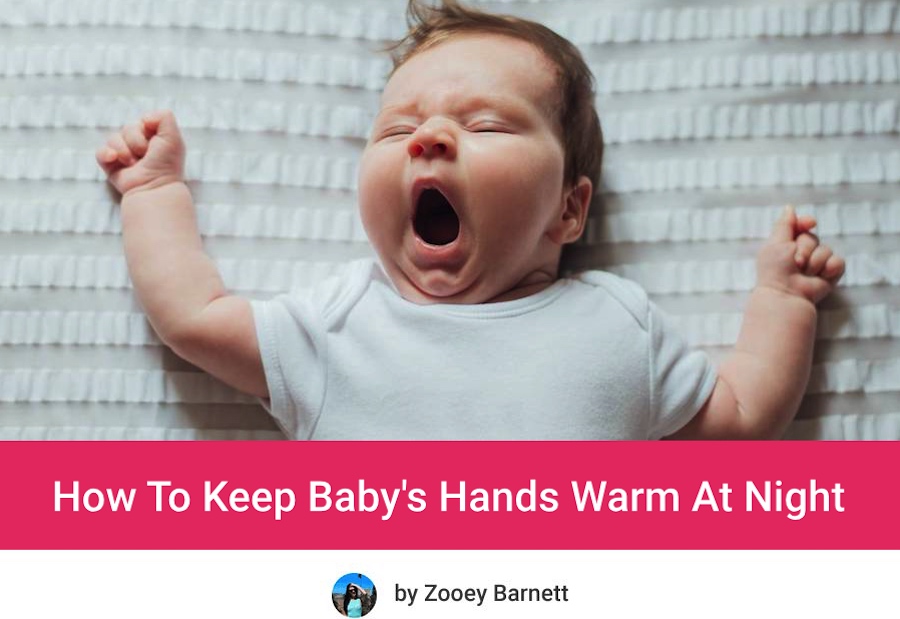
Have you ever worried about getting the the correct temperature in baby’s nursery? Stressed about how how many layers your newborn should wear so they aren’t too cold at night? Then you’re in good company, because I was constantly worried about how to keep my baby warm at night!
I remember fussing over how to dress my newborn on cold nights: was I dressing in too many layers, or not enough? Should they wear socks on top of their footie pajamas? Should baby’s arms be out or should I keep them wrapped in the swaddle for extra warmth?
During cold weather, I worried about keeping baby’s hands warm, especially if they were fighting the swaddle and keeping their hands exposed. But, I also didn’t want to cause my infant to be too hot and uncomfortable, either.
Adults can easily deal with cold winter nights by adding warm blankets or setting up a space heater, but babies, especially newborns, cannot use those same techniques to keep warm. If you’ve ever worried about ensuring your baby’s bed or sleeping space is warm enough during colder months, or obsessively check baby’s temperature to feel for cold hands, keep reading.
In this post, I share how to manage cold nights and keep your baby warm, while still following safety standards for baby sleep. There are ways to keep baby warm that don’t include electric blankets or an unsafe heating pad.
Before becoming a mom I had no idea that there could be so much to think about when it came to baby’s sleep environment. I’m not talking about the important rules to help prevent sudden infant death syndrome, (no loose bedding, no crib bumpers in baby’s crib). Those aspects are important, and should not be overlooked – the sleeping environment is important!
But I’m thinking more about how to keep baby warm at night. I never knew there was so much to consider when it came to pajamas and sleep sacks.
This article is not a substitute for medical advice or consultation
Is It OK If My Baby’s Hands Are Cold At Night?
Let’s start with the biggest, most obvious question: is it okay for your baby to have cold hands at night?
It’s actually totally normal for your baby’s hands and feet to feel cooler, especially during sleep. While newborns cannot regulate their temperature very well right away, this doesn’t mean there is something wrong, even if their hands and feet feel cold.
This has to do with circulation, or the way blood flows through the body. As long as your baby’s core temperature is warm, and they have no other symptoms of illness (fever, labored breathing) then there is nothing to be concerned about1.

As always, if you have concerns about your infant’s body temperature, (specifically a consistent body temperature) consult your pediatrician.
| PRO TIP: Are you worried about your little one getting cold at night? In this article we discuss whether it’s safe fro babies to sleep with socks on. Make sure to read it too! |
Why Does My Baby Have Cold Hands At Night?
There are various reasons why those cute tiny hands get cold at night – and they differ for newborns and older babies.
Newborn Babies
The reason for cold hands in infants varies, depending on age. But for newborns, it mostly comes down to temperature regulation.
- Temperature regulation
- Not well-dried after a bath
- Young babies need slightly warmer environments than adults
Let’s dive deeper into each of these causes.
1. Newborns Cannot Regular Their Body Temperature Yet
Newborn babies need help to stay warm at night and retain their body heat. As they grow older, they will develop the ability to regulate their own body temperature, but they need help at first2.
This means wrapping them up nice and cozy and usually dressing them in an extra layer of clothing (or a sleep sack or swaddle blanket) when they sleep.
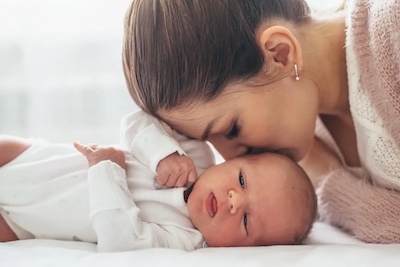
2. After A Bath
Another reason babies get cold is because they aren’t properly dried off after a bath. If your infant is crying and wriggling, you may be rushing to dress them and soothe them. But, their cold hands could be from air in contact with their wet body3.
Remember that to keep a newborn baby’s temperature regulated they need to be dry and dressed in an extra layer of clothes.
3. Babies Need To Be Warmer Than Adults
Even if your little one doesn’t have cold hands, they likely need an extra layer for sleeping.
This is dependent on the weather, they may need two extra layers during cold weather. A sleep sack or snug swaddle can count toward an extra layer, but pay attention to the TOG rating to be sure.
Older Babies (1 Year And Older)
Older babies also get cold hands at night, and this is usually related to normal circulation of blood throughout the body.
- Blood circulation
- Room temperature
- Climate
- Check core temperature
Now let’s take a closer look at each of these possible causes.
1. Blood Circulation
The way the blood flows throughout the body is circulation. The priority regions for blood flow are around the major organs in a person’s abdomen and neck/head. The last place blood flows is to the hands and feet, which is why these are the first places to get chilled, even in infants.
A baby might be warm at night in their sleep sack, but their hands are cold. Make sure to check baby’s body, not only their hands, to determine if they are chilly.

2. Is Your Baby’s Room Just Too Cold?
Even if you dress your baby properly, keeping your nursery too chilly could be the reason for cold hands. Keep them warm at night and turn up the thermostat!
3. Season/Climate
If it’s winter and there is snow on the ground, it makes sense that your baby might feel colder at bedtime, too. Consider moving baby’s crib away from drafty windows set up thermal curtains to retain heat and keep your infant warmer at night.
Should Baby Hands Be Covered When Sleeping?
Covering a baby’s hands is really about your own preference. However, if you choose to cover a baby’s hands, make sure it is done in a safe way – with no suffocation risk or hazards around your sleeping baby.
I prefer baby pajamas that have fold-over sleeves around the hands. These are not only cute and practical, but they are a safe option to cover your baby’s hands without risking using separate accessories that could fall off and become hazards.
Remember, it is not required that you cover your baby hands when sleeping, even if they do feel a bit cold. Try dressing your baby in warm clothes, to ensure their core body temperature is in a normal range, though.
How Do I Keep My Baby’s Hands Warm While Sleeping?
A baby who is cold may wake frequently, but a warm and cozy baby generally gets longer, more restful sleep. Here are some practical ways to keep your baby’s hands warm at bedtime4.
1. Swaddle
Using a swaddle can be a game-changer for keeping your newborn’s hands warm at night. Wrapping your baby in a swaddle will give them that cozy and snuggly feeling, and help them sleep better through the night.
Remember tho – you can only swaddle young infants who can’t roll over yet.
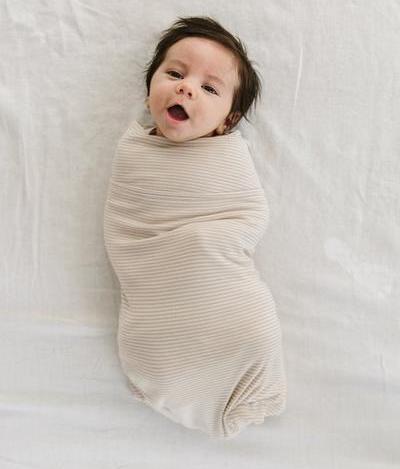
2. Check The TOG Rating On Baby Sleep Sacks
A TOG rating measures how warm a blanket (or an infant sleep sack, in this case) is.
For summer months, choose breathable lightweight sleep sacks – something that is 0.5 or 1 TOG.
All-season sacks work from spring through fall, and are for climates with mild winters. These are usually are usually 1-1.5 TOG.
A wearable blanket that is 2 or even 3 TOG is very warm, and is great for winter.
Choose an appropriate TOG rating for your weather5 to help your baby stay warm at night.
Frankly, in my opinion sleep sacks are the best way to keep child warm at night (whether you have a toddler or infant). Sleep bags will help your kiddo sleep through the whole night without waking up because of cold!
3. Use Long Sleeved Pajamas
In winter months dress baby in pajamas or long sleeve onesies and then in their sleeping sack or swaddle..
My favorites are pajamas that have fold-over sleeves. These can act as mittens to keep baby’s hands warm at night.
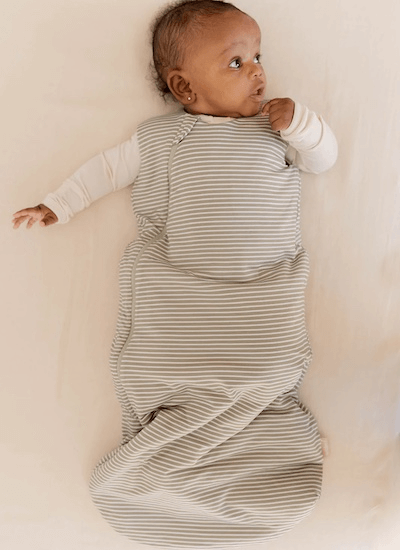
4. Sleep Sacks With Long Sleeves In Winter Months
If temperatures drop below freezing, it can be a good idea not only to dress baby in extra layers, but make sure the arms are covered, too6.
Since older babies shouldn’t be swaddled (stop swaddling once baby can roll over), a sleep sack with sleeves is a great option. Choose one with a TOG rating of 2 or higher.
5. Keep Baby’s Room Warm Enough
Ensure your baby’s room or nursery is warm at night – but not too hot, either! The ideal room temperature (according to experts7) is between 62-78°F. Frankly, I know it may sound like a chilly nursery, but it’s important to keep baby’s room at this temperature. Baby shouldn’t sleep under any covers or blankets, of course you can put them in a sleep sack – made from the right fabric for the season.
Control the room temperature with a thermostat (not a space heater). Space heaters are too dangerous to use in your infant’s nursery. The best method to ensure a comfortable temperature and a safe sleep space is to use a thermostat to control the temperature.
6. Pre-Warm Baby’s Seeping Space With A Hot Water Bottle
Prepare a hot water bottle and set it on baby’s sleeping space for a few minutes (around 8-10 is enough). Then, remove the hot water bottle from the bed entirely (don’t just set it aside, it must be out of the crib) and place your baby over that some warmed space.
This little trick is also great for shifting a baby who fell asleep in mama’s arms to their crib. There will be less of a temperature difference between the cold sheets and your warm arms, so they are less likely to wake up when you set them down in bed.
7. Socks & Mittens
Try adding socks to your baby feet to keep his feet warm, even if you’re dressing him in footie pajamas.
Young babies can sleep with mittens on their hands to help them stay warm. If you don’t have baby mittens, just pop baby socks on their hands to get he same effect.
How Do I Stop My Baby’s Hands From Getting Cold At Night? – Methods You Should NOT Try
I know lots of parents might be thinking about more obvious way to keep hands warm at night: cozy bedding or fluffy blanket. Although it may be tempting to do that – it’s NOT SAFE!
Let’s talk more about the methods you should NOT try when you want to warm your baby’s hands.
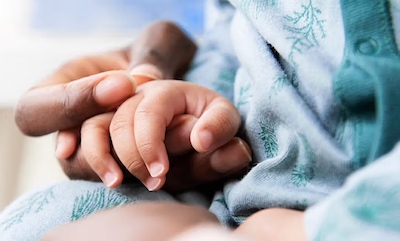
Newborns & Babies Under 1 Year Old
Let’s start with things you should avoid with newborns and infants.
1. Don’t Add An Extra Blanket To Keep Your Baby Warm
Newborns can either be swaddled or wear a sleep sack (aka: wearable blanket), but do not use a blanket or any loose bedding with a child in their first year of life. This poses a serious suffocation risk and could have fatal consequences.
Use a blanket when you’re holding your little one in your arms, or pushing them in the stroller. But once you move them to their crib or bassinet, they should be laid down on their back, with no loose blankets.
2. Don’t Use A Baby Hat
Baby hats are completely fine to use during wake hours, but when your infant is asleep you should remove it.
It’s not only about the risk of suffocation, but a baby who is wrapped up snuggly in a sleep sack or swaddle needs a way to release excess heat. Your baby’s head allows heat to escape and helps to balance their body temperature. Covering a baby’s head may increase risk of overheating.
Babies Over 1 Year Old
Now, a few dangerous methods that you shouldn’t try even with toddler.
1. Blankets NOT To Use
While your 1-year old can start sleeping with a blanket, there are some blankets that are not allowed to use with babies or toddlers.
These include weighted blankets or an electric blanket. Neither of these are safe options for babies.
By the way, if you want, there’s no rule that says you can’t keep using sleeping sacks. They make them in big sizes, up to 3 years old!
2. Don’t Use A Space Heater
Space heaters are not safe for baby’s rooms8.
Do not use a space heater in your nursery or near your baby’s bassinet or crib. Choose other options, or consider temporarily bringing baby into your bedroom (but not into your bed) if their nursery is that cold.

Keeping Baby Warm At Night – FAQ
How can you tell if your baby is cold or comfortable? Is there any problem with a baby being too warm? Let’s look at some common questions.
How Do I Know My Baby Is Cold At Night?
- Check core temperature
Checking a baby’s temperature by the hands (or other cold extremities, such as feet) is not a good way to determine if your baby is actually cold because it can be due to poor circulation.
The better way to determine a baby’s body temperature is to feel their back or belly with the palm of your hand.
If they are chilled, you need to put on an additional layer of clothes or a thicker sleep sack.
But if their core body feels normal and warm, then you don’t need to add or remove any layers.
- Look for signs of being cold
A baby shows signs of being cold by acting fussy or wanting to be carried/cuddled.
If your baby doesn’t want to be out of your warm arms or settle down for the night, they might be chilly They may also hug their arms close to their body but they likely will not shiver the way adults do when they are cold.
Check their core body temperature with your hand as the best way to determine if an infant is cold.
How Do I Know My Baby Is Too Warm At Night?
While your first concern might be if your baby is too cold, don’t go to the other extreme and cause your baby to be too hot. If your baby appears sweaty take off some layers and help them cool down.
Overheating is a serious concern (and is associated ith sudden infant death syndrome), so make sure you know the signs of overheating in babies:
- Red face
- Sweating (you may need to check under their clothes, for sweating around the neck or back
- They feel warm all over
- May be irritable or lethargic
Yes, it’s important to keep your baby warm, but avoid overheating, too.
How Do You Keep Your Baby Warm At Night Without A Swaddle?
Swaddling is an easy way to keep your baby cozy, but it is not the only way address your baby’s cold hands. Other options include:
- Pajamas with fold-down hand covers
- Mittens
- Sleep sack with sleeves
Should My Baby Wear Mittens At Night?
Experts recommend that babies should only wear mittens until they reach two weeks old. Many parents use them to prevent scratching, because newborn nails are so sharp, but so hard to trim. If you want to use them to keep your infant’s hands warm, just make sure there are no choking hazards like long strings.
Mittens are certainly not a ‘must-have’ baby item, though, since they are used for such a short period of time. Some moms never use mittens with their babies.
When Do Babies Stop Wearing Mittens?
Babies only wear mittens for the first few weeks of life. As they grow, they should learn to use their hands, so avoid covering them constantly with mittens.
If you want to know more about mittens for babies, check out my in-depth article: When do babies stop wearing mittens?
The purpose of this article is informative. It’s not a substitute for professional medical advice or medical care. Remember: safety first! Consult your doctor/pediatrician in case of any doubts. The author of this article does not accept any responsibility for any liability, loss or risk, personal or otherwise, incurred as a consequence, directly or indirectly, from any information or advice contained here.
Picture of baby in a swaddle belongs to Solly Baby Brand. Source. https://sollybaby.com/
Pictures of baby in a sleep sack belongs to WildBird Brand. Source: https://wildbird.co/
Resources:
https://www.stanfordchildrens.org/
https://www.webmd.com/
https://www.medicalnewstoday.com/
https://www.nestdesigns.com/
https://utswmed.org/
http://halosleep.com/
https://www.babycenter.com/
https://www.mothersandmore.org/

